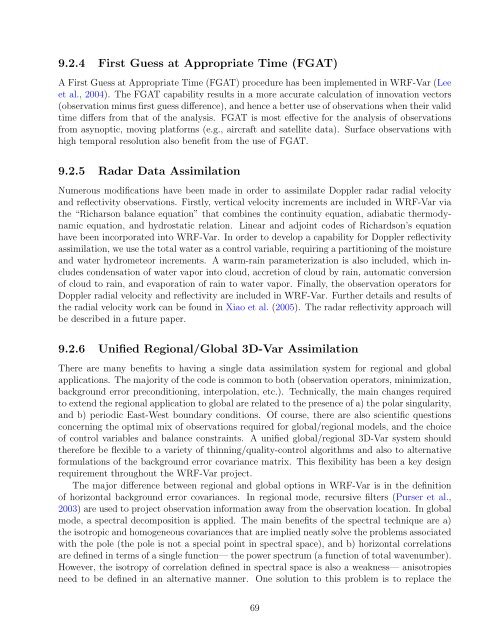Advanced Research WRF (ARW) Technical Note - MMM - University ...
Advanced Research WRF (ARW) Technical Note - MMM - University ...
Advanced Research WRF (ARW) Technical Note - MMM - University ...
You also want an ePaper? Increase the reach of your titles
YUMPU automatically turns print PDFs into web optimized ePapers that Google loves.
9.2.4 First Guess at Appropriate Time (FGAT)<br />
A First Guess at Appropriate Time (FGAT) procedure has been implemented in <strong>WRF</strong>-Var (Lee<br />
et al., 2004). The FGAT capability results in a more accurate calculation of innovation vectors<br />
(observation minus first guess difference), and hence a better use of observations when their valid<br />
time differs from that of the analysis. FGAT is most effective for the analysis of observations<br />
from asynoptic, moving platforms (e.g., aircraft and satellite data). Surface observations with<br />
high temporal resolution also benefit from the use of FGAT.<br />
9.2.5 Radar Data Assimilation<br />
Numerous modifications have been made in order to assimilate Doppler radar radial velocity<br />
and reflectivity observations. Firstly, vertical velocity increments are included in <strong>WRF</strong>-Var via<br />
the “Richarson balance equation” that combines the continuity equation, adiabatic thermodynamic<br />
equation, and hydrostatic relation. Linear and adjoint codes of Richardson’s equation<br />
have been incorporated into <strong>WRF</strong>-Var. In order to develop a capability for Doppler reflectivity<br />
assimilation, we use the total water as a control variable, requiring a partitioning of the moisture<br />
and water hydrometeor increments. A warm-rain parameterization is also included, which includes<br />
condensation of water vapor into cloud, accretion of cloud by rain, automatic conversion<br />
of cloud to rain, and evaporation of rain to water vapor. Finally, the observation operators for<br />
Doppler radial velocity and reflectivity are included in <strong>WRF</strong>-Var. Further details and results of<br />
the radial velocity work can be found in Xiao et al. (2005). The radar reflectivity approach will<br />
be described in a future paper.<br />
9.2.6 Unified Regional/Global 3D-Var Assimilation<br />
There are many benefits to having a single data assimilation system for regional and global<br />
applications. The majority of the code is common to both (observation operators, minimization,<br />
background error preconditioning, interpolation, etc.). <strong>Technical</strong>ly, the main changes required<br />
to extend the regional application to global are related to the presence of a) the polar singularity,<br />
and b) periodic East-West boundary conditions. Of course, there are also scientific questions<br />
concerning the optimal mix of observations required for global/regional models, and the choice<br />
of control variables and balance constraints. A unified global/regional 3D-Var system should<br />
therefore be flexible to a variety of thinning/quality-control algorithms and also to alternative<br />
formulations of the background error covariance matrix. This flexibility has been a key design<br />
requirement throughout the <strong>WRF</strong>-Var project.<br />
The major difference between regional and global options in <strong>WRF</strong>-Var is in the definition<br />
of horizontal background error covariances. In regional mode, recursive filters (Purser et al.,<br />
2003) are used to project observation information away from the observation location. In global<br />
mode, a spectral decomposition is applied. The main benefits of the spectral technique are a)<br />
the isotropic and homogeneous covariances that are implied neatly solve the problems associated<br />
with the pole (the pole is not a special point in spectral space), and b) horizontal correlations<br />
are defined in terms of a single function— the power spectrum (a function of total wavenumber).<br />
However, the isotropy of correlation defined in spectral space is also a weakness— anisotropies<br />
need to be defined in an alternative manner. One solution to this problem is to replace the<br />
69
















